It’s great that many people are replacing grass with low-water landscaping, especially in the Southwest where lawns don’t make sense. One concern (along with trees not getting adequate water) that I’ve noticed is the widespread use of weed barrier cloth. Our Redlands CA fire stations have even used it in their waterwise demonstration projects.
While it might help with weeds initially, weed barrier cloth not necessary and is even harmful. First, what is it?
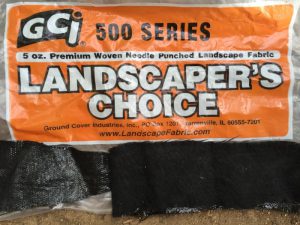
Many people have used black plastic to kill weed and grass seeds before planting. This has evolved to geotextiles, which are woven so that water and gas exchange can occur and light penetration is reduced. Fewer weed seeds germinate so it’s become a popular landscaping tool, and usually covered with mulch.
Dr. Linda Chalker-Scott, an Extension Horticulturist and Associate Professor at Washington State University, has written about the increasing use of geotextiles. She says they can be effective in agricultural situations, in annual planting beds, or where the landscape is regularly disturbed and the fabrics can be replaced when needed.
Chalker-Scott says for permanent landscapes, however, “they are not a long term solution and in fact can hinder landscape plant health.”
Bad for soil health and weeds long-term
Bettina McLeod runs the school garden project at Cope Middle School and has been ripping out the weed cloth she discovers from previous landscaping. “Earthworms get stuck in it and die, roots penetrate it so you can’t pull the weeds out, and it breaks up after years leaving little fragments and who knows what its made of,” she said.
Weed cloth is also one of April Garbat’s pet peeves. The Whittier-based landscape designer and ISA certified arborist says the hard-packed soil underneath seems dead and smells like dust with no visible organisms.
“That’s partly because weed cloth interferes with the natural process where leaves fall to the ground and mulch the plants from which they fell, renewing the soil community. The dark-colored plastic also heats the soil more than natural mulch does, and may not allow much water through to the soil,” Garbat said.
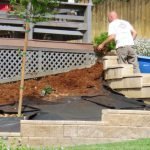
She also finds that often the mulch, or gravel on top doesn’t stay, so the fabric degrades, especially when exposed to sunlight. Then the weeds grow through. “The most frustrating weeding I’ve done is trying to remove weeds that have either sprouted from under the fabric through tears, or rooted in it from the top from seeds that blew in,” she said. Although professional grade fabric may last longer, weed cloth is a short-cut that Garbat says only lasts a few years.
Bad for earthworms, native bees…
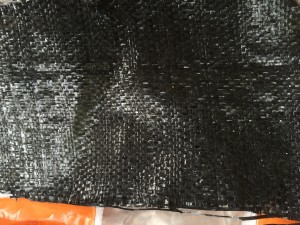
As McLeod has discovered at the school, weed cloth is impenetrable for earthworms and all burrowing invertebrates. These include native bees, most of which nest in the ground and are increasingly becoming important as pollinators. Click here for info on native bees & other pollinators.
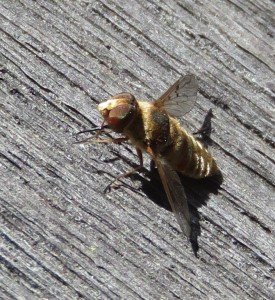
Inhibits changes to a garden
While many landscape designs are meant to grow and fill in over time, weed cloth can strangle a trunk or stem, and it prevents runners from plants that might be intended to spread out. “Small succulents, large agave, and grasses are common drought-tolerant plant choices, but they can’t spread out and fill in a space when weed cloth is used,” says Garbat. Or a gardener may want to swap plants out but weed cloth makes these changes more difficult, as holes must be cut in the fabric in order to plant.
When to use it and what to use instead
Garbat has used weed barrier, for example under thick decomposed granite pathways where she doesn’t want plants to grow, and where it won’t surface. However, she doesn’t use it in flagstone paths where she is going to plant succulents or little groundcovers in between the stones.
Instead of weed cloth, both Chalker-Scott and Garbat recommend a thick three to six-inch layer of wood mulch. Arborist wood mulch is leftover from tree jobs and can be found at no cost. Imported wood mulches, such as gorilla hair, is available for purchase at nurseries and home improvement centers.
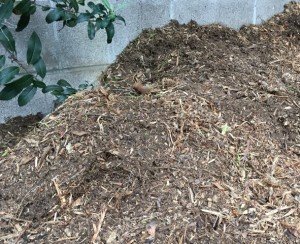
We were successful with just using mulch, both redwood mulch and also mulch from several dead trees and shrubs we had removed on our property and chipped. We paid to have most of our dead lawn dug out in 2008 and the first year we did pull out some grasses and weeds that came up, but really not that many. Now, the mostly native plants have filled in, forming a great ecosystem, and weeds are minimal.
If it’s already there
For people who already have it, Garbat suggests making sure plants have lots of room cut out for them, at least the diameter of their root ball, and that it is a completely cut-out circle, not an X or slash. “Then, as the weed cloth becomes visible and less effective in the following years, slowly remove swaths of it before you replenish the mulch.”
For more info:
Utah State University fact sheet on how to help nesting native bees (including not using weed barrier cloth)
Chalker-Scott (Washington State Puywallup Extension) article on weed barrier
Chalker-Scott review “Impact of Mulches on Landscape Plants and the Environment”
A landscaper article (Mike’s Backyard Nursery) about his experience with weed cloth
Yes, for sure. I’m also worried about artificial turf. It keeps our rain water from percolating into our groundwater table. Recharging our groundwater is critical to our native vegetation.
On another note; as you know, Redlands is not a desert. But our beautiful trees are succumbing to our 5 years of desert-like conditions. I’m worried that we may be over-doing our concern over this drought by not deep watering our beautiful trees that can normally survive our summers (because we normally get enough winter precipitation …14″ usually in a season). Our watering over the long dry summer helps these trees survive until next seasons rains. We have some 1/2 century old trees that we need to preserve. Do you agree?
Hi John, yes, I’m very concerned about our trees with the movement to drought tolerant landscaping. I’m on the Redlands Street Tree Committee and we’re actively trying to make sure our beautiful old trees get enough water to survive. We personally have 4 rain barrels that assure our trees and other landscaping get adequate water at least during the rainy season. And yes, you’re right that most need supplemental water during the winter months.
I have an issue where our neighborhood has a semi-gale force wind season. I am the only home owner on my street without a tree on my property, yet I get tons of leaves and dust/dirt. I get weeds easily, and multch is difficult to keep tidy from both leaf debris and weeds. any suggestions?
Hi Chad, you don’t say where you live but wind can be a real issue. I usually go to what nature does best on its own – check with your state native plant society and look at native plants that survive well where you live – grasses come to mind. When we replaced our lawn with mostly native plants we had to weed for a couple years but then their broad cover of the ground competed well with weeds. Also see what grows in windy natural areas and pick the best ones that you like best, knowing that a little extra water will improve their looks. You can do groundcover plants that don’t grow high. Also, all plants including natives, like sprays occasionally to get dust off. Good luck.